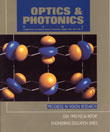
August 1991 Issue
- Color Vision
- Retinal Regulation of Visual Contrast Sensitivity
- Mechanisms for Motion Perception
- The Use of Neuroimaging in the Study of Vision
- Optical engineering challenges of the IBM 3800 laser printer: Part I
- EC '92 pushing ophthalmic standards
- Otherwise the sky would be black ...
- Browse all Issues
Feature Articles
The most useful question to ask initially about color vision is "What is it good for?" The best answer is probably that it allows us to distinguish and identify objects that otherwise would be confused. This emphasis on the properties of objects prompts us to ask whether the characteristics that determine their colors are stable, and how these characteristics might be economically represented in the brain. Most surfaces do have stable attributes, so one might cast the problem of color vision as one of representing the color attributes reliably, despite differences in the conditions under which the objects are viewed.
by Peter LennieRetinal Regulation of Visual Contrast Sensitivity
Sensitivity to contrast is one of the most important attributes of the visual system of humans and other animals. This paper is about some of the reasons for the dependence of visual responses on contrast, and the neural machinery in the retina that makes it possible. Although it seems that perception of the brightness of objects is effortless, visual scientists have known for years that complex neuronal computations are required to perform the task. The perception of brightness is not simply a matter of counting photons. The primary determinant of brightness perception is local contrast—the local difference between luminances on either side of a boundary normalized by the (local) average luminance.
by Robert ShapleyMechanisms for Motion Perception
One the goals of vision science is to understand the workings of visual systems from the diverse perspectives of psychophysics, neurophysiology, and computation, and to develop this understanding into an integrated theory of vision. This program has been particularly successful in the study of motion perception.
by Edward AdelsonThe Use of Neuroimaging in the Study of Vision
Visual neuroscience has been the focus of inquiry across many disciplines and has produced an explosion of understanding about how visual information is processed. A fundamental question is: Where are the computations necessary for vision performed?
by Steven E. Petersen, Francis M. Miezin, Maurizio Corbetta and Marcus E. RaichleOptical engineering challenges of the IBM 3800 laser printer: Part I
The IBM 3800 laser printer is a computer system printer that uses a He-Ne laser, acousto-optic modulator, and rotating polygonal mirror to produce raster scanned electrophotographic printing. It was the first commercially available laser printer and was originally designed for 144 x 180 PEL/inch resolution. It incorporated a forms flash system for forms overlay and merging with computer generated printing. Depending on the timing of the engineering activity, "engineering challenges " can be: (a) a feature of the basic design or (b) solutions to problems incorporated at some later stage in the research/development/manufacturing process. Part I deals with the optical design challenges encountered during development. Part II will discuss the manufacturing challenges.
by Milt R. LattaEC '92 pushing ophthalmic standards
This month we focus on more global issues of standardization and consider some of these issues as they relate to ophthalmic optics. There are presently two international efforts being pursued in optics standardization—one a truly international effort sponsored by ISO and the other a European-based effort run by CEN that is motivated by the 1992 free market plan for Europe.
by Robert E. ParksOtherwise the sky would be black ...
The other day, my daughter was in a chattery mood, and commented to me that it's sometimes hard having a "scientist" for a mom, because you can't always discuss things with her. "How's that?" I asked. "Well, one of the great mysteries of childhood is why is the sky blue? Every kid has their own theory. But I can't even discuss it with you, because you'll tell me why it's blue." I think she has a point. We all know kids love to be impressed with experiments, but often young kids really prefer not to hang around for an explanation. And I'd forgotten how much fun it is just to speculate. I remember in high school my friends enjoyed talking about dilemmas like what if a car is doing the speed of light and you turn on the lights. Sometimes speculating can be more interesting than finding out, when you're young.
by Janet Shields

![Manual probe system with needles for test of semiconductor on silicon wafer. [A. Morozov / Getty]](https://opnmedia.blob.core.windows.net/$web/opn/media/images/articles/2025/1125/departments/202511-cover-web.jpg?ext=.jpg)
![Researcher Clara Saraceno in the lab. [Image by Carsten Behler Photography]](https://opnmedia.blob.core.windows.net/$web/opn/media/images/articles/2025/1025/departments/202510-cover-web.jpg?ext=.jpg)
